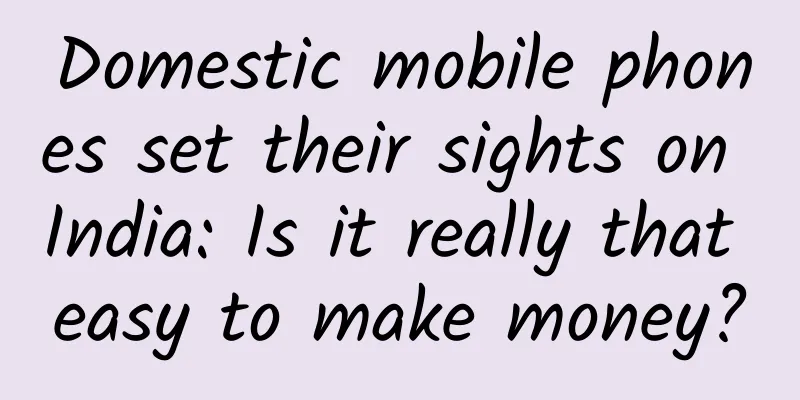Domestic mobile phones set their sights on India: Is it really that easy to make money?

|
When it comes to India, the author's impression in the past is that its population is second only to China, it is better at football than China, it eats with the right hand, Microsoft CEO Satya Nadella is Indian, and there are many operators (more than 10). However, recently the word India has frequently appeared in my mind: Xiaomi mobile phone sales in India have been suspended due to a patent dispute with Ericsson, on December 15, vivo mobile phone held a press conference in New Delhi, India to launch new products to enter the local market, OnePlus mobile phone has begun to focus on the Indian market, Huawei plans to invest tens of millions of dollars in India to establish e-commerce channels... India, a neighbor of China, has relatively backward infrastructure construction. The penetration rate of smart phones is not high but is growing very rapidly. Data shows that India's population reached 1.21 billion in 2013, ranking second in the world. According to the reference data provided by ZTE, India's LTE construction is expected to achieve a 100% growth in 2014. In addition, the share of non-smart phones in the Indian market is still as high as 71%, and the demand for smart phones is as high as hundreds of millions of units. After several years of rapid development, the overall growth of China's mobile phone market has slowed down. The fierce competition will inevitably eliminate some brands in the future. Going abroad has become a feasible way for many local mobile phones to maintain long-term competitiveness. Based on the above information, India is obviously another smart phone market with huge potential after China. It is no coincidence that many domestic mobile phone brands have coincidentally targeted this emerging market. As early as the end of 2013, vivo president Shen Wei publicly stated that in the next five years, vivo will focus on international markets such as India, Indonesia, Thailand and Malaysia. Recently, vivo successfully entered the Indian market, which can be said to have fulfilled the promise made at that time. This year, Xiaomi launched several rounds of sales for Xiaomi 3 and Redmi Note phones in India, and the scenes of them being sold out in seconds almost replicated the success of Xiaomi phones when they were first launched in China. Less than four months after entering the Indian market, the cumulative sales of Xiaomi models in the local market have exceeded 500,000 units. Hugo Barra, Xiaomi's global vice president, even boasted that "Xiaomi's growth in the Indian market is expected to surpass that of China." Coincidentally, OnePlus phones recently tried to sell in India at a price of about 2,200 yuan, and tens of thousands of them were also sold out in an instant. Xiaomi and OnePlus' initial success in India was exciting, and seemed to have pointed a clear path for domestic mobile phone brands to go abroad. However, Xiaomi's subsequent setbacks in the Indian market poured cold water on everyone: Don't be too happy too soon. Success often requires the three elements of time, place, and people. Taking Xiaomi as an example, it basically meets the time and place. First of all, it coincides with the early stage of rapid growth of smart phones in India, and the timing is very good; as for the place, India is a neighbor of China, and it has the most developed railway network and the longest train line mileage in the world, and transportation is relatively convenient. Unfortunately, "people" still has many uncertainties and complexities. You must be on guard when you go out, especially patents, which some people use for self-defense and others use for attack. Regarding the ban on the sale of Xiaomi mobile phones in India, Ericsson pointed out that it has been trying to have a dialogue with Xiaomi on patent licensing issues for products based on GSM, EDGE and UMTS/WCDMA standards for more than three years, but Xiaomi has always refused to respond, so it took legal action. If domestic mobile phones want to become stronger and bigger when going overseas, patents are always a hurdle that cannot be avoided. In the past, people may have thought that European and American countries are particularly sensitive to patent issues and rarely have loopholes to exploit, so they gave priority to developing countries in Asia. However, with ZTE recently sending a lawyer's letter on patent infringement to some domestic mobile phone brands, and Xiaomi mobile phones being temporarily banned from sale in India due to patents, the reality shows that there will be fewer and fewer "safe havens". Chinese companies need to realize the importance of intellectual property rights as soon as possible and make planned long-term investments and accumulations. Why is it that the younger OnePlus mobile phone is so successful as it also goes abroad to "make phones"? It's not because of any clever tricks. OnePlus founder Pete Lau said in an interview with South Korea's Chosun Ilbo, "We will face (patents) squarely and will not avoid them. We will study hard on the parts we don't understand, and we should pay patent fees according to regulations, right? The essence of entrepreneurship is the process of solving these problems." To put it bluntly, the money that should be spent still needs to be spent. In the long run, "marketing without spending money" is just a false proposition. You will always have to pay for what you have done. According to IDC data, Samsung accounted for 17% of the Indian smartphone market in the second quarter of this year, Nokia reached 10%, Micromax, Karbonn and Lava, the three major Indian local brands, accounted for 31% of the market share, and the remaining 42% was divided by other brands. In 2012, Samsung's market share in India once reached 35.1%, but it evaporated by half in less than two years. After being acquired by Microsoft, Nokia will focus on Windows Phone models. The future development momentum of the two brands in the Indian smartphone market is not optimistic. This is undoubtedly a great opportunity for Chinese mobile phone brands to exert their strength in the Indian market. Moreover, data shows that low-priced smartphones are very popular in India, which is precisely the advantage of many Chinese mobile phone brands. Of course, being cheap is not enough. When in Rome, do as the Romans do. Indian policy does not allow foreign online retailers to own wholly-owned companies and sell products directly in India, so they need to cooperate with local e-commerce companies. Xiaomi previously chose Flipkart, and OnePlus teamed up with Amazon. In addition, there are many cooperation opportunities among the many operators in India, and there are many ways to play. If local mobile phone brands can gain a foothold in such a fierce mobile phone market in China, they will have a bright future if they do their homework and pay enough tuition fees to fight in India and make good products. As a winner of Toutiao's Qingyun Plan and Baijiahao's Bai+ Plan, the 2019 Baidu Digital Author of the Year, the Baijiahao's Most Popular Author in the Technology Field, the 2019 Sogou Technology and Culture Author, and the 2021 Baijiahao Quarterly Influential Creator, he has won many awards, including the 2013 Sohu Best Industry Media Person, the 2015 China New Media Entrepreneurship Competition Beijing Third Place, the 2015 Guangmang Experience Award, the 2015 China New Media Entrepreneurship Competition Finals Third Place, and the 2018 Baidu Dynamic Annual Powerful Celebrity. |
<<: Why do we Chinese prefer iPhone 6 plus?
>>: Why does WeChat lower the overall IQ of Chinese people?
Recommend
"Investment and Business" advanced course!
"Investment and Business" 2020 Advanced...
What to do when being besieged by killer whales? Sperm whales: Let's do it together | Nature Trumpet
Welcome to the 55th issue of the Nature Trumpet c...
Can these "artificially synthesized meats" that have already appeared on the table really replace natural meat? The truth...
In the past few decades, as the global population...
Soil is alive! These bugs help plants grow
Produced by: Science Popularization China Author:...
Android source code, imitating Dianping pull-down animation
Source code introduction: Imitate the pull-down s...
After working on information flow for half a year, I found these 3 points to be super useful!
When it comes to information flow , I think most ...
Amazing! Liquid metal can also be magnetic. Let's take a look at the world-class research results of Chinese scientists
Scientists Liang Hu, Liu Jing and others from the...
Review of semi-finished food delivery service: Can you save time and effort while also having deliciousness and health?
If you have already formed a small family and hav...
How to utilize consumers’ five senses to develop an operational strategy that ignites user desires?
We who work in operations communication often say...
"Leshan fried skewers are recommended to be banned" has caused controversy! Don't worry, do these 3 things and eat skewers healthily!
Leshan, Sichuan, carries the joy of foodies. If y...
Baidu search promotion OCPC daily optimization guide (Part 2)
Recently, many students have been asking question...
How to use coupons to increase the conversion rate of education and training companies?
In recent years, the penetration rate of online e...
How to build a SaaS product from 0 to 1
For a SaaS product, it is very important to build...
The ancient buildings of the Forbidden City, full of intrigue, contain the wisdom and romance of our ancestors
In April, the Forbidden City is full of blooming ...
Timely warning and comprehensive deployment in many places to actively respond to blizzards and cold waves
Affected by the cold wave, the temperature in the...









